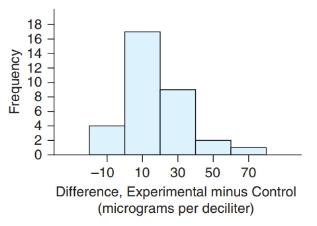
Concept explainers
Lead Exposure (Example 3) Excessive lead levels can negatively affect brain

The differences were found by calculating “factory child’s lead level minus matched control child’s lead level.” Lead levels were concentrations in the blood, measured in micrograms per deciliter. A positive difference means the child of a factory worker has a higher lead concentration than the child in the control group. The data consisted of 1 tie (the same value for the child and the matching child), 28 pairs in which the factory worker’s child had a higher level, and 4 pairs in which the factory worker’s child had a lower level of lead.
Carry out a sign test to determine whether children whose parents are exposed to lead at work have a higher lead level than children whose parents are not exposed to lead at work. Use a significance level of 0.05 to see whether the experimental group had higher levels of lead.
(These data appear in Trumbo [2001].)
Want to see the full answer?
Check out a sample textbook solution
Chapter 13 Solutions
INTRODUCTORY STATISTICS (LOOSELEAF)
Additional Math Textbook Solutions
Elementary Statistics: Picturing the World (7th Edition)
College Algebra (Collegiate Math)
Thinking Mathematically (6th Edition)
Elementary Statistics ( 3rd International Edition ) Isbn:9781260092561
Graphical Approach To College Algebra
Probability And Statistical Inference (10th Edition)
 Glencoe Algebra 1, Student Edition, 9780079039897...AlgebraISBN:9780079039897Author:CarterPublisher:McGraw Hill
Glencoe Algebra 1, Student Edition, 9780079039897...AlgebraISBN:9780079039897Author:CarterPublisher:McGraw Hill Holt Mcdougal Larson Pre-algebra: Student Edition...AlgebraISBN:9780547587776Author:HOLT MCDOUGALPublisher:HOLT MCDOUGAL
Holt Mcdougal Larson Pre-algebra: Student Edition...AlgebraISBN:9780547587776Author:HOLT MCDOUGALPublisher:HOLT MCDOUGAL College Algebra (MindTap Course List)AlgebraISBN:9781305652231Author:R. David Gustafson, Jeff HughesPublisher:Cengage Learning
College Algebra (MindTap Course List)AlgebraISBN:9781305652231Author:R. David Gustafson, Jeff HughesPublisher:Cengage Learning Big Ideas Math A Bridge To Success Algebra 1: Stu...AlgebraISBN:9781680331141Author:HOUGHTON MIFFLIN HARCOURTPublisher:Houghton Mifflin Harcourt
Big Ideas Math A Bridge To Success Algebra 1: Stu...AlgebraISBN:9781680331141Author:HOUGHTON MIFFLIN HARCOURTPublisher:Houghton Mifflin Harcourt




